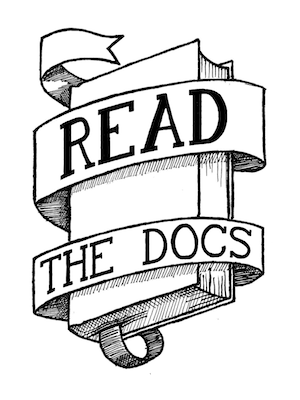Read the Docs Update¶
It’s been a while since I last talked about Read the Docs, and there has been a lot of activity. This is an update on the latest and greatest new features.
PSF Funding¶
The biggest news that has happened is that we have been given a grant from the Python Software Foundation to help host the site. Thanks PSF! They have blogged about it, and I am grateful that they have given us support. With the funds they have offered, we have been able to make Read the Docs a lot faster, and more robust. I will outline some of the changes below.
This also means we won’t be going away any time soon!
New Theme¶
We have a fancy new theme for documentation on Read the Docs! If you have the ‘default’ theme for your project, it will show up on the build of your docs on the site. I think it is pretty great, thanks to the designers who spent their time making it awesome. A really great feature is that the new theme is mobile ready. Go ahead and view a project using it on your phone, or make your browser smaller and you will see the fanciness. Having a custom theme will give us a base to build lots of other neat features on top of.
Better architecture¶
We had some connectivity trouble in between our servers a while back, and this prompted me to make the site respond better to these conditions. Every time you view documentation on a subdomain of readthedocs.org, your request will never hit Django. So all of these requests will work without a database. We have also added a second application server with a load balance in front, which means that one of the app servers could go away and your documentation would still get served.
That leaves our load balancer as the main single point of failure at the moment. We’re using Varnish for the load balancer, and we’ve implemented strong caching of data. Varnish will cache your docs for up to a week, and it will be actively purged when you rebuild your docs. This means that your docs will usually be served out of memory, and without dependence on any other server but that one. We have plans to elininate Varnish as a single POF, and then it would only be our hosting provider that would be a single point of failure (famous last words).
Intersphinx support¶
Intersphinx is an awesome feature of Sphinx that allows you to reference remote sphinx documentation easily. RTD now supports it for every project that we host.
Improved rtfd.org¶
I’ve always had big ideas for rtfd.org, since it can act as a short-url for things. projectname.rtfd.org has always redirects to the projects docs, but now we have something a lot better. Inspired by Jacob Kaplan-Moss and his work on django.me, we now support human-edited deep-linking within documentation hosted on RTD.
Taking another page from Jacob’s book, we seeded the index of our projects with their Intersphinx data, so a lot of references will automatically work. This works best with API reference docs, but anything people have put links to in their documentation should have been picked up. A couple of examples:
If you go to a non-existent link on rtfd.org, you will be prompted to enter a suggested URL. This will help build the data, and make it more useful for everyone.
rtd command line utility¶
RTD has had an
API
for a while now, and with the addition of the support for rtfd.org,
I thought it would be neat to make it easier to access docs from
the command line. With a simple pip install rtd, you will get
an rtd utility that will open docs on RTD. It supports 2 arguments,
the first being a project name, and the second being a slug to
append for the rtfd.org functionality. So like the example above:
-> rtd pip
Pip Installs Packages.
Opening browser to http://pip.rtfd.org/
-> rtd celery Task
Distributed task queue
Opening browser to http://celery.rtfd.org/Task
It hits the RTD API to see if the project is on the site, and only opens your browser if it doesn’t exist. I hope that in the future we’ll make it easy to upload a project from the shell, and more.
More docs¶
Since we are a documentation site, we’ve always had documentation. I’ve been adding more as time has gone on, and most of the features I’ll be talking about today are already documented. I also broke the documentation up into sections for users of the site, and developers on the codebase, so it should be easier to find for everyone to find what they are looking for.
Conclusion¶
I think that RTD can be doing a lot more to help out the community with regards to documentation. I’ll write another post about that soon. But if you are interested in helping out with the effort, all of the code is open source and we love people to contribute. Feel free to jump in #readthedocs on Freenode as well, if you have any questions or thoughts.


